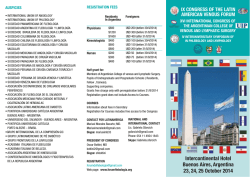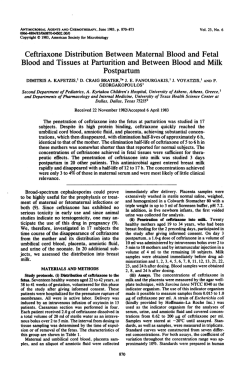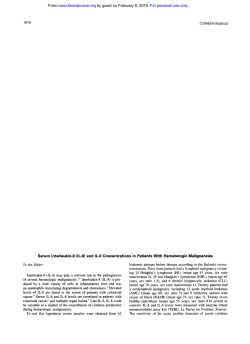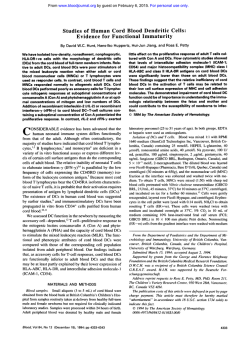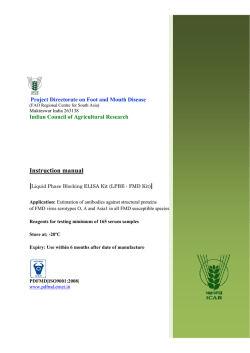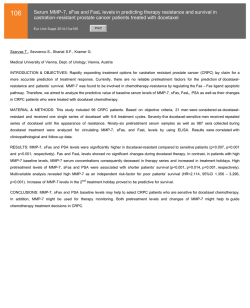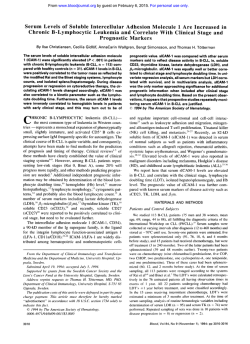
Comparison between umbilical artery and vein
SAMJ VOL 79 16 FEB 1991 197 Comparison between umbilical artery and vein endogenous digoxin-like immuno-active factor • levels in normal and pre-eclamptic patIents I. SCHABORT, H. J. ODENDAAL, C. J. LOMBARD, Summary Recent studies have pointed to the existence of an endogenous digoxin-like immuno-active factor (DLlF), which may be associated with hypertension and pre-eclampsia. The DLlF levels in the umbilical venous and umbilical arterial blood of neonates, as well as the maternal serum of primigravidas and multigravidas with and without pre-eclampsia, were determined by means of a commercially available radioimmunoassay kit, which is cross-reactive with DLlF, in 44 mothers and their babies in search for a possible placental, fetal or maternal origin of the DLlF. The mean placental and neonatal masses were significantly lower in the pre-eclampsia group than in the control group (P < 0,01). However, the DLIF levels in the maternal serum, umbilical cord venous and umbilical cord arterial serum were statistically significantly higher in the pre-eclampsia group than in the control pregnant group (P< 0,05). A very strong correlation was found between umbilical cord venous and arterial DLIF levels (r = 0,90; P = 0,001, Spearrnan rank-correlation coefficient). Although the mean DLIF level in cord arterial serum was lower than that of cord venous serum, statistical significance was not reached if the Bonferronl adjustment was applied to the P value. S Air Med J 1991; 7t: 197-199. Recent studies have indicated the existence of an endogenous digoxin-like immuno-reactive factor (DLIF).I,2 There are interesting indications that this DLIF could be involved in the pathophysiology of essential hypertension 3 and it may also be associated with pre-eclampsia. 4 The presence of a DLIF has been demonstrated during oral salt loading 5 in patients with renal impairment, in newborn infants, during the third trimester of pregnancy,2 and also in patients with active acromegaly.6 DLIFs in plasma from hypertensive patients have been shown to inhibit the sodium-potassium adenosine triphosphatase (ATPase) of normal blood vessels, red cells and white cells. 7 Inhibition of sodium-potassium ATPase and the sodium-potassium pump has also been reported at tissue and cellular levels in patients with low-renin hypertension. 7,8 Various tissues have been reported to contain DLIF, e.g. extracts of mammalian brain,9 rat adrenal tissue,IO and placental tissue.!l Department of Obstetrics and Gynaecology, University of Stellenbosch and Tygerberg Hospital, Parowvallei, CP l. SCHABORT, M.B. CH.B., B.SC. HONS (EPIDEMIOL.), B.se. HONS (BIOCHEM.) (present address: 2619 51 Ave, Lloydminster, Albena, Canada) U. J. ODENDAAL, F.R.e.O.G., M.D. lnstitute for Biostatistics of the South African Medical ~esearch Council, Parowvallei, CP C. J. LOMBARD, PH.D. t. BREDELL, B.Se. "'=pted 29 Feb 1990. l\q>rint requests to: Professor H. J. 0de0daa1, Dept of Obstetrics and Of Stellenbosch, PO Box 63, Tygerberg, 7505 RSA. GYD2='logy, University L. BREDELL The hypothalamus, pituitary and possibly the adrenal glands, under the influence of the hypothalamus, have been postulated as being the source of the DLIF. 6.8.!2 In this study, DLIF levels in the umbilical vein, umbilical artery and maternal serum in patients with and without preeclampsia at delivery were measured in a search for a possible placental, fetal or maternal origin of the DLIF. This is the first study, to the authors' knowledge, investigating both the venous and arterial umbilical cord blood levels of DLIF. Subjects and methods From the patients who delivered at Tygerberg Hospital, 44 were selected at random for this study approximately proportional to the prevalence of pre-eclampsia in the primi- and multigravida populations. The study was approved by the Ethical Comminee of the University of Stellenbosch and informed consent was obtained from all subjects. Blood samples were obtained by catheterising the umbilical vein and artery separately at delivery, and from a peripheral maternal vein immediately after delivery. All samples were collected in glass tubes and refrigerated. Serum digoxin levels were determined within 72 hours after collection. According to clinical data collected during labour and from their antenatal records, patients were categorised into four groups, viz.: primigravidas with and without pre-eclampsia and multigravidas with and without pre-eclampsia. For some comparisons, the mothers without pre-eclampsia were regarded as a reference or 'control' group, and those with pre-eclampsia as the 'pre-eclampsia' group. In order to make the diagnosis of pre-eclampsia, the blood pressure had to be 140/90 mmHg or more on two occasions at least 6 hours apart and accompanied by 150 mg/l proteinuria or more and/or oedema. None of the patients were on digoxin therapy, and except for those who were diagnosed as having pre-eclampsia, all were considered to be healthy. A commercially available radio-immunoassay from Clinical Assays (Cambridge, Massachussens, USA) was performed in accordance with the manufacturer's instructions as described in local studies done previously on the different available commerical kitS. 4,ll A Packard Autogamma counter was used to determine the radio-activity of the iodine-125-labelled digoxin. Control sera were used to prepare standard curves from which digoxin levels ranging from 0 ng/m! to 4 ng/m! could be determined automatically by the microprocessor of the gamma counter. None of the patients had been receiving digoxin, and the determined digoxin level was accepted to be caused by the immunoreactive cross-reacting substance. Statistical methods Since it is known that fetal DLIF levels correlate inversely with gestational age and birth weight,l8 the DLIF levels in maternal serum, cord venous and cord arterial blood were adjusted for gestational age by using the 50th percentile of the birth-weight charts for gestational age, sex and primi- or multigravidas of Keen and Pearse,13 and Jaroszewicz et al. 14 198 SAMJ VOL 79 16 FEB 1991 Dividing the three DLIF variables by the median weight for the gestational age gave DLIF levels/g median weight for gestational age. The Spearman correlation coefficient was used to test for association between pairs of continuous variables. The Wilcoxon rank-sum test was used to test for differences between mean values of two groups while the paired (-test was used in the case of paired data. The Bonferroni adjustment was applied to the P value when multiple comparisons were made. DLIF data Clinical data Although the mean mass of the babies (1994 ± 913 g v. 2993 ± 651 g) as well as the placental mass (410 ± 115 g v. 529 ± 142 g) in the pre~eclampsia group were significantly lower than in the control group, the DLIF levels in the maternal serum, cord venous and cord arterial blood were significantly higher in the pre-eclampsia group when adjusted for gestational age of baby (Table Ill). A moderate correlation was found between maternal venous and cord venous DLIF levels (r = 0,4784; P = 0,001), while cord venous and cord arterial DLIF levels showed a strong association (r = 0,89756; P = 0,0001 Spearman rank-eorrelation coefficient). The results obtained are shown in Table I. Pre-eclampsia occurred in 11 patients. As was to be expected, gestational age at birth was significantly lower in the pre-eclampsia group (34,5 ± 5,2 weeks) than in the control group (38,9 ± 2,8 weeks) (Table 11). Although the mean DLIF levelS in cord arterial serum were lower than that of cord venous serum (Table Ill), statistically significant differences could not be demonstrated when the Bonferroni adjustment was applied to statistically significant results obtained using Student's paired (-test. Results TABLE I. CLINICAL MEASUREMENTS AND DLlF LEVELS (MEAN Maternal age (yrs) Gestational age (wks) Systolic blood pressure (mmHg) Diastolic blood pressure (mmHg) Mass of baby (g) Placental mass (g) DLlF level of mother (ng/ml) Cord venous DLlF (ng/ml) Cord arterial DLlF (ng/ml) Group I (N = 13) 20,1 ± 2,6 38,0 ± 4,1 128 ± 10 ±8 74 2925 530 0,66 1,25 1,19 Group 11 (N = 7) 19,3 ± 2,3 36,3 ± 3,6 160 ± 12 106 ± 702 ± 126 ± 0,28 ± 0,26 ± 0,30 Group I ~ primigravidas without pre-eclampsia; group 11 IV ~ multigravidas with pre-eclampsia. = Maternal age (yrs) Gestational age (wks) Systolic blood pressure (mmHg) Mass of baby (g) Mass of placenta (g) Control = 2993,0 529,0 ± 651,0 ± 142,0 TABLE Ill. DLlF LEVELS (MEAN ± SD) Control (N = 33) Control = Pre-eclampsia (N = 11) 23,3 ± 7,0 34,5 ± 5,2 158,0 ± 13,0 ± 5,0 ± 2,8 ± 13,0 primi- and multigravidas without pre-eclampsia; pre-eclampsia Maternal serum DLlF (ng/ml) Cord venous DLlF (ng/ml) Cord arterial DLlF (ng/ml) 0,75 ± 0,58 1,36 ± 0,39 1,34 ± 0,43 primi- and multigravidas withoui pre-eclampsia; 3037 528 0,81 1,43 1,44 = Group IV (N = 4) 30,25 ± 7,6 31,3 ± 6,4 155 ± 17 ±9 ± 631 ± 154 ± 0,71 ± 0,44 ± 0,48 110 1 655 288 0,71 2,02 1,90 ± 12 ± "1223 ± 70 ± 0,48 ± 0,45 ± 0,56 multigravidas withoui pre-eclampsia; group SD) IN CONTROL AND PRE-ECLAMPSIA GROUPS Control (N = 33) 24,4 38,9 118,0 70 primigravidas with pre-eclampsia; group III ± SD) IN THE FOUR GROUPS Group III (N = 20) 27,2 ± 4,02 39,4 ± 1,4 112 ± 10 ± 11 2187 ± 722 500 ± 61,9 0,81 ± 0,17 1,49 ± 0,46 1,44 ± 0,55 TABLE 11. CLINICAL MEASUREMENTS (MEAN Measurement ± 1 994,0 410,0 = P-value (Wilcoxon rank sum test) NS 0,016 0,001 ± 913,0 ± 115,0 0,002 0,009 primi- and multigravidas with pre-eclampsia. IN CONTROL AND PRE-ECLAMPSIA GROUPS Pre-eclampsia (N = 11) 0,78 ± 0,30 1,69 ± 0,51 1,61 ± 0,58 pre-eclampsia~primi- P-value for values adjusted for and multigravidas with pre-eclampsia. gestational age 0,0131 0,0142 0,0463 SAMJ Discussion The difference in maternal age between the primigravidas and multigravidas is easily explained. The gestational age in the pre-eclampsia group was significantly lower than in the control group, probably because these pregnancies had to be terminated ~arlier due to the pre-eclampsia. It is known that DLIF levels in the fetus correlate inversely .with gestational age and weight. IS In this study both the placentas and babies were smaller in the pre-eclampsia groups, but DLIF levels were higher in the pre-eclampsia group. This .was compensated for by statistically adjusting for gestational ilge and mass of the baby. When this was done, maternal serum DLIF levels, cord venous and cord arreriallevels were found to be statistically significantly higher in the pre~clampsia group (Table Ill). There is recent evidence for a circulating endogenous inhipitor of the sodium-potassium pump in the plasma of some ,ubjects with low renin hypertension. ,3 Immunoreactive DLIF jevels were found to be significantly increased in the cord plood of patients with pre-eclampsia, and the levels were felated to the severity of the pre-eclampsia. 4 Reduced sodium-potassium ATPase activity was found in (.rythrocytes of infants born to pre-eclamptic mothers. This could be due to a substance that suppresses sodium-potassium j\TPase activity. 16 These observations suggest the presence of another system !Jesides the renin-angiotensin aldosterone, antidiuretic hormone 1lIld atrial natriuretic peptide systems for the regulation of plasma volume and arterial pressure. This has led to a hypothesis regarding the genesis of low-renin volume expanded hypertension. Increased intravascular volume due to impaired excretion of sodium and water by the kidney is sensed by the central circulation and results in the release of a DLIF. Like the cardiac glycosides, this substance increases intracellular sodium, which leads to a diminished calcium effiux from the cells. This increases cardiac contractility, constricts blood vessels and reduces the renal tubular absorption of sodium. The increased blood pressure and reduced sodium reabsorption results in excretion of the excess volume. An agent with this combination of properties would represent an effective way to rid the body of extra salt and water. The increase in blood pressure'would deliver more salt and water to the renal tubule, from which they would be excreted. This agent would also help to explain why populations prone to low-renin hypertension (e.g. blacks and elderly people), who excrete a sodium load more slowly than normal when they are normotensive, excrete the load more rapidly than normal when they are hypertensive. IS There is evidence for hypothalamopituitary-adrenal regulation of body fluid balance. A study in patients with active acromegaly showed return of very high levels of sodium pump inhibitor to control values after adenomectomy.6 Experimental lesions of the hypothalamus decrease DLIF levels in the blood. 3 Data recently published 17 indicate that linoleic and Oleic acids act as endogenous sodium-potassium ATPase inhibitors. These compounds were isolated and identified from VOL 79 16 FEB 1991 199 porcine plasma after the pigs had undergone volume-expansion experiments. In our study, the other possible source of DLIF would be the placenta, as supernates from homogenates of human placen~ tissue at term have been shown l8 to contain almost three times as much DLIF/g protein as normal human serum. Measuring umbilical cord arterial and venous DLIF levels in our study, we could not demonstrate any consistent difference between the DLIF levels in the serum originating from the fetus and placenta, respectively. It is therefore impossible to suggest a predominant fetal or placental source of origin. The precise structure of DLIF is not yet known but the substance seems to be associated with pre-eclampsia, and hypotheses about the source and action of DLIF can be tested by further studies. The authors wish to thank Mrs J. M. Barnes for help in preparing the manuscript and the South Mrican Medical Research Council for supplying fInancial support. REFERENCES I. Valdes R jun. Endogenous digoxin-immunoreactive substance measured in several patient populations. Prog Clin Bioi Res 1985; 192: 221-228. 2. Valdes R jun. Endogenous digoxin-immunoactive factor in human subjects. Fed Proc 1985; 44: 2800-2805. 3. Haddy FJ, Pamnani MB. Evidence for a circulating endogenous Na'-K' pump inhibitor in low-renin hypertension. Fed Proc 1985; 44: 2789-2794. 4. Odendaal HJ, Beyers AD, Van Heyningen CF, Spruyr LL, Koue TJVW, Van Jaarsveld PP. Immunoreactive digitalis-like substance in pre-eclampsia. S Afr Med] 1986; 70: 535-537. 5. Klingmuller D, Weiler E, Kramer HJ. Digoxin-like natriuretic activity in the urine of salt-loaded healthy subjects. Klin Wochenschr 1982; 60: 1249-1253. 6. Deray G, Rieu M, Devynck MA et al. Evidence of an endogenous digitalislike factor in the plasma of patients with acromegaly. N Engl] Med 1987; 316: 575-580. 7. Pamnani MB, Oough DL, Huot SJ, Haddy FJ. Sodium-potassium pump activity in experimental hypertension. In: Vanhoune PM, Leusen I, eds. Vasodilalalion. New York: Raven Press, 1981: 391-403. 8. De Wardener HE, Oarkson EM. Concept of natriuretic hormone. Physiol Rev 1985; 65: 658-759. 9. Lichtstein SD, Samuelov S. Membrane potential changes induced by the ouabain-like compound extracted from mammalian brain. Proc NaIl Acad Sci USA 1982; 79: 1453-1456. 10. Schreiber V, Stepan J, Gregorova I, Krejcikova J. Crossed digoxin immunoreactivity in chromatographic fractions of rat adrenal extract. Biochem Pharmaco11981; 30: 805-806. 11. Beyers AD, Spruyt LL, Seifarr HI, Kriegler A, Parkin DP, Van Jaarsveld PP. Endogenous immunoreactive digitalis-like substance in neonatal serum and placental extracts. S Afr Med] 1984; 65: 878-882. 12. Wijdicks EFM, Vermeulen M, Van Brummelen P, Den Boer NC, Van Gijn ]. Digoxin-like immunoreactive substance in patients with aneurysmal subarachnoid haemorrhage. Br Med] 1987; 294: 729-732. 13. Keen DV, Pearse RG. Bitthweigbt between 14 and 42 weeks' gestation. Arch Dis Child 1985; 60: 440446. 14. Jaroszewicz AM, Schuman DEW, Keet MP. Intra-uteriene groeistandaarde van Kaapse kleurlingbabas. S Afr Med] 1975; 49: 568-572. 15. Haddy F]. Endogenous digoxin-like factor or factors. N Engl] Med 1987; 316: 621-622. 16. Kuhnert BR, Kuhnert PM, Murray BA, Sokol R]. Na/K and Mg-ATPase activity in the placenta and in maternal and cord erythrOCytes of preeclamptic patients. Am] Obstel GynecoI1977; 127: 55-60. 17. Tamura M, Kuwano H, Kinoshita T, Inagami T. Identification of linoleie and oleic acids as endogenous Na"K'-ATPase inhibitors from acute volumeexpanded hog plasma.] Bioi Chem 1985; 260: 9672-9677. 18. Valdes R jun. Endogenous digoxin-like immunoreactive factors: impact on digoxin measurements and potential physiological implications. Clin Chem 1985; 31: 1525-1532.
© Copyright 2026
